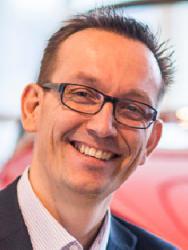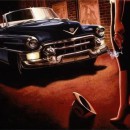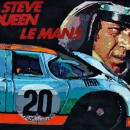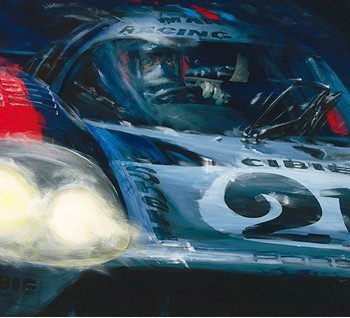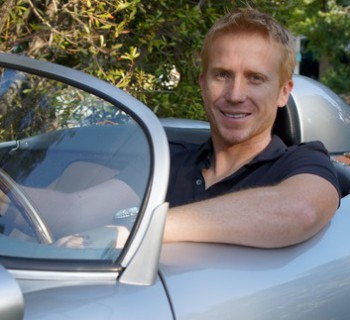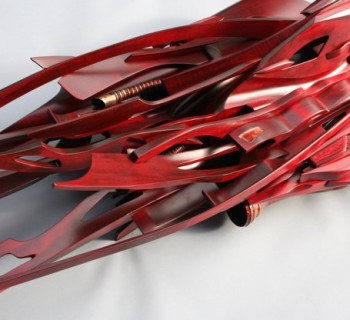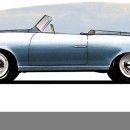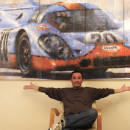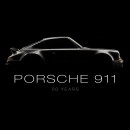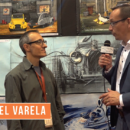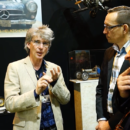Brian Casey's 16 foot collage and his personal tribute to Ayrton Senna.
How did you get started?
From a very young age I have always been interested in racing and motor sport. I lived within ear shot of Crystal Palace racing circuit. I have always been interested in art but when I left school, my parents wanted me to get a job for security. So I went to work for a bank for sixteen years before being made redundant in 1994. After that, I decided to totally change my outlook on life and my direction. I wanted to learn a skill and become a sign writer, painting shop signs in a traditional way. It was a brave change in direction but I learned a lot and with sign writing it gave me my interest in lettering. In my spare time, I drew portraits and pets for family and friends and I had a friend who was a Bike Marshall in motorbike racing. I went with him for three years and was allowed to take my camera onto the circuit. Spectators are always behind the fence but now here I was, actually in front of the fence and I think this fuelled my obsession for motor racing.
For me my real interest in motor racing came later on after I got married and moved just twenty minutes away from Brands Hatch. I then rekindled my childhood love for motor racing. I managed to get a job at Brands Hatch, where I worked for a year and met a lot of racing drivers and bump riders. It was a fantastic experience. I had access to all areas and could go in the paddock, anywhere and I got to meet the drivers and mechanics and get close to all the cars. That was a wonderful experience. I used it as a place to collect all my photographic work for future pictures. With the superbikes and Formula 1, there is writing all over the cars and bikes and I think that is what interested me. The fact that I could use my sign writing along with my illustration for motoring art. During this time I decided to become an illustrator and a painter. I took my work from being a sign writer to becoming an artist.
In my earlier years, I was painting and just earning a living but now I am trying to live the dream.
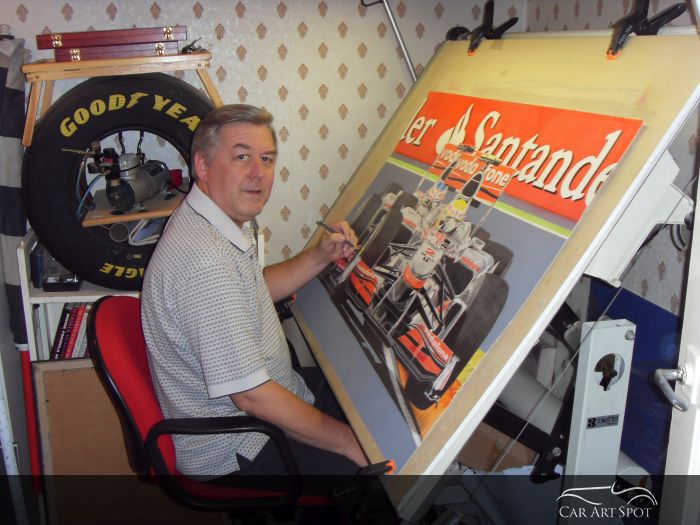
Brian Casey at work in his studio
I notice you put so much intricate detail of the buildings in your paintings.
I LOVE a challenge. I look at each one of the football stadiums and I see all the work which has gone into the architecture. That is what draws my attention to the stadiums, the iron work and the colossal buildings which people congregate to. I just love it. I am able to continue that with Formula 1 when they go all around the world, to Monaco, Valencia and places like that and where all the street work comes into the vehicles as well.
Are you considering applying the same technique to painting racing circuits?
I would love to continue along that theme. It would be nice if formula 1 go to more street circuits because then I could look more into the building side of it. If I see something difficult, I love the challenge. Each coliseum is a challenge in itself. I think Formula 1 is going that way, they are not necessarily sticking to round circuits but are coming out more and introducing a few more street circuits and that would most certainly be my interest.
You pay a lot of attention to the background. Can you explain why you do that?
I elaborate so much on the detail of the background and buildings because with the vehicle and the particular building I put in at that time, I try to capture the emotion of speed against a monumental building which is just standing there, and the excitement of the racing that is going past it. I try to get into the detail and draw out both.
You manage to capture the emotion and adrenaline in your work. How do you do that?
Some of the pictures I have produced have been commissioned. One of the paintings on my website is a tribute to Graham Hill celebrating his win at Monte Carlo Grand Prix in 1965. He asked me to colour up some black and white photographs. I did a lot of research into which colours the buildings were, back in 1965 and managed to work from black and white photo's. What is fantastic about this picture is the fact that it was produced working completely from the black and white photos. It is fantastic what you can achieve. Here is a video of Brian Casey working at it.
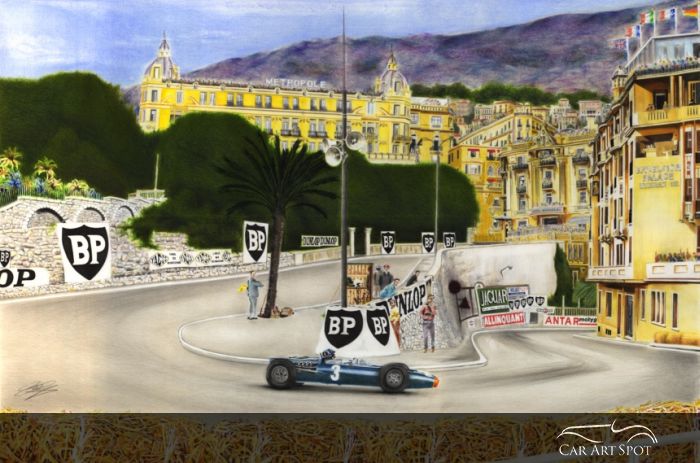
Graham Hills big victory at the Monte Carlo Grand Prix in 1965 by Brian Casey
I go to the auto sport exhibitions at the beginning of the year and they show and demonstrate all the cars for the coming season. I take as many photographs as I can. Alexander Palace in the UK, has a motorbike show and exhibit all this years' worlds' super bikes and cars. I usually go out and collect as much photographic material as I can. At the Auto Sport Exhibition in January, all the brand new cars are all completely on show and it's absolutely fantastic.
You have two types of formula 1 artwork. The ones with the scenery and the ones with the drivers. You show the same driver from two or three different views. Why is that?
I put a portrait in my paintings and like to put the driver in either the left or the right hand side. It draws more out of the picture and makes it more human. It livens it up a bit.
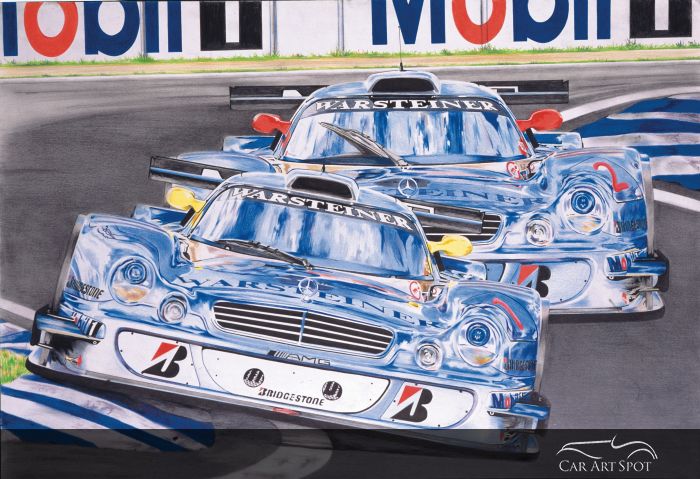
Fine Art Paintings of GT Racing by Brian Casey
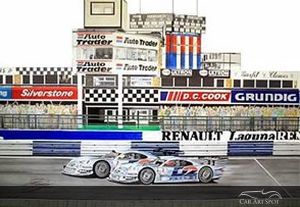
Fine Art Paintings of GT Racing by Brian Casey
In some of your other artwork, super cars, touring and classic cars, there is no background at all. The focus in on the car.Why is that?
I was once approached by a guy who was producing book markers. He wanted a series of touring cars, supercars, classics and convertibles. So I did a series of twelve of each and they were used as bookmarks and this is how they got onto my website. Each one of the touring cars was taken at Brands Hatch.
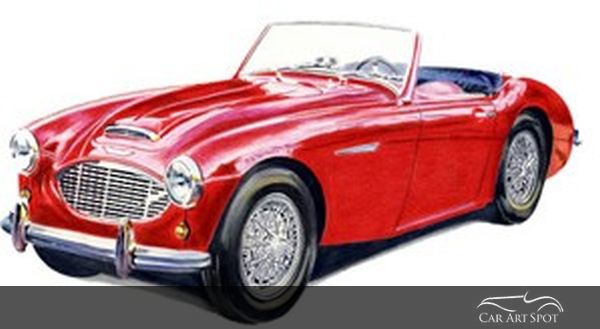
Classic Convertible Austin Healey by Brian Casey

Super Car Dodge Viper by Brian Casey
What are the techniques you use?
I use pencils, pens and some water colour. Pretty much most of my work is done in pencil because then I can keep all the detail and go deep in and get really sharp images. This is why I choose to use a dry medium and pencil or pen. I did start out as a water colour artist but couldn't get all the detail I wanted. So I went over to a dry medium.
When I am putting a background into a Formula 1 drawing or MotoGP, I will quite often airbrush the circuit to get a nice flat surface and possibly use water colour for the grass, livery and signage. The vehicle is predominantly done with pencils. So it is a mixture of pencils and water colours.
With classic convertibles. How do you pick the angle, view and type of car?
I find the best angle is from the front left or front right with the tyre turning out towards the road. It makes the car or the vehicle look a little bit angry. I have learned over the years that a certain angle of a certain car or bike will bring it to life, if you can just turn the wheel. If I am composing a picture, I ask if I can have the tyre turning slightly out to make it look more dynamic and give it more character.
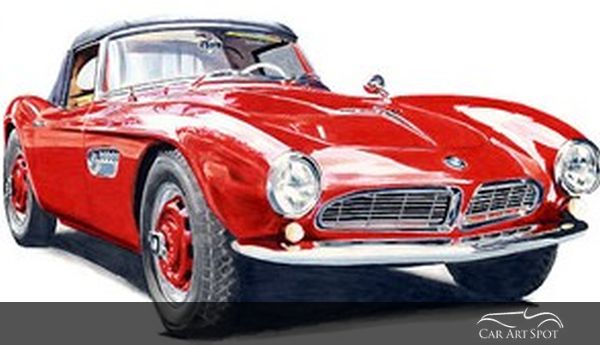
Classic Convertible BMW by Brian Casey
Where do you find your inspiration? What triggers new work?
My inspiration normally comes from many months of having an idea. When it's ready I start implementing it and it's usually while I am doing something else at the same time. I usually have three or four pictures in my head and four on the go, all at the same time. I am at the moment at my drawing board and two football stadiums which I am working on. One is finished and one is in a nearly finished state. The football stadiums are taking up most of my time at the moment. I am also working on two other pictures and one is a very large picture. I have a painting on You Tube which I did and it was 16 foot long. My studio is a box room 8 feet x 10 feet. I did that 16 foot picture in a 10 foot room. I set up two tubes and as I did one bike, I rolled the paper on and then added another bike. So it was all done on a drawing board and as I finished one bike, I rolled it onto the next one.
Isn't it complicated to get the dimensions and lighting?
This goes back to the planning, preparation and then putting it down on paper. When I first thought of that idea, I bought a ten meter roll of art paper on the internet. As soon as I saw it, I thought I am going big. This paper demands a big picture. The paper told me where to go. That is when I came up with the idea of rolling the paper. All the bikes were done in pencil and each bike had the same angle. When it was finished, I hired a room for three weeks which was big enough for three six foot easels and 16 foot of ply. I put the paper onto the 16 foot and then airbrushed the background in. All the six bikes were finished and then I did the background. It took four months from start to finish for this project. The most work was the airbrushing and the big sign in the background. The sign alone took me four weeks to complete. It was a thrilling experience and I am now thinking of doing a picture of 10 meters (30 feet).
Did you sell your artwork with the bikes?
I contacted The Corkscrew at Laguna Seca Circuit and sent them the images over. Unfortunately, they couldn't handle such a large picture and were afraid it would get damaged. I also approached Red Bull and although they absolutely loved it, they unfortunately couldn't endorse or accept it because they didn't commission it. It is a fantastic beautiful piece of work and is currently rolled up nice and safe in my studio.

A fantastic16 foot collage by Brian Casey
In your videos, all your work fits on your drawing board. Is that the size you usually work on?
Normally in my studio I have got an AO drawing board (slightly bigger than the norm). Most of my drawings or illustrations are usually about A1 in size.
Are you promoting your artwork yourself?
Yes I self promote. I do not have any other outlets.
Do you have contact with other artists to share your passion?
I am a member of the Guild of Motoring Artists. I meet up with Richard Wheatland, David Purvis and other artists usually once a year. We go to the Silverstone Classic or Goodwood. If there are Land Rover events going on, we sometimes exhibit artwork over there. That is when I get to talk to other motoring artists. I find it fantastic being around similar minded artists. I think they are fantastically clever. I do not usually meet artists from outside of Europe.
I can imagine you have customers from all over the world.
Absolutely. I have a fantastic client base and sell my work in Europe and all over the world. It is lovely meeting other people and talking to them. Customers don't just order a print, they sometimes call me and we have a chat. I love that. It's lovely to talk to people. It's like you are not just selling a product. It brings an emotion to it and we share a passion. When the public come and talk to me, I get a buzz out of what I do and the feedback I get from people.
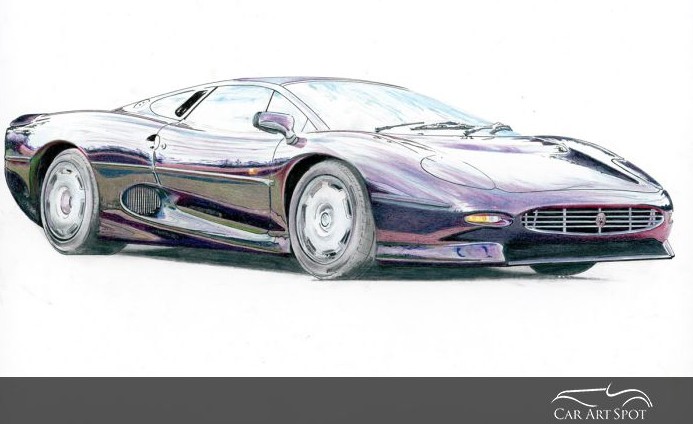
Supercars Jaguar XJ220 by Brian Casey
Do you do much commission work?
I do more commission work than what my website brings in. Most of the time, people contact me for commission work. They want pictures done for their boyfriends, partners etc. It starts with one thing and grows into something quite different. Sometimes they want their partners' car painted and then ask for their partner to be standing next to their pride and joy. For me it is important to understand the emotion of the future owner of my artwork. That is what makes it worthwhile. Art needs to trigger emotion. I get that more from doing trade shows. I love the interaction with the audience.
Do you sell much work at the trade shows?
If I do the big shows (Goodwood, Silverstone), they like to see you drawing but people are not there to buy artwork. When I do the smaller bike and car shows, people are more willing to buy.
On the day, I don't usually hear a lot from people because people generally think they are disturbing me. But when I get home, the phone rings and it's someone who was at the show. Then we get talking. Every time I have ever done any shows, I have always demonstrated. I don't just want to ask people for money, I want people to buy into my product. When people see the detail and the craftsmanship, they feel more pleased to buy something from me.
Brian Casey's tribute to Ayrton Senna
"I did my personal tribute to Ayrton Senna and put all my emotions into that montage. I had a lot of respect for him. It was a real tragedy when he died. If he had of survived, I think he would have possibly of been as successful as Michael Schumacher". A quote by Brian Casey.
I really enjoyed this interview. Thank you for sharing your passion.
It was a pleasure. I love talking to people about art.
Interested in buying or commissioning art by Brian Casey? Please go to: www.drawingfromthebest.com
You can also see more of Brian Casey's work on You Tube.

